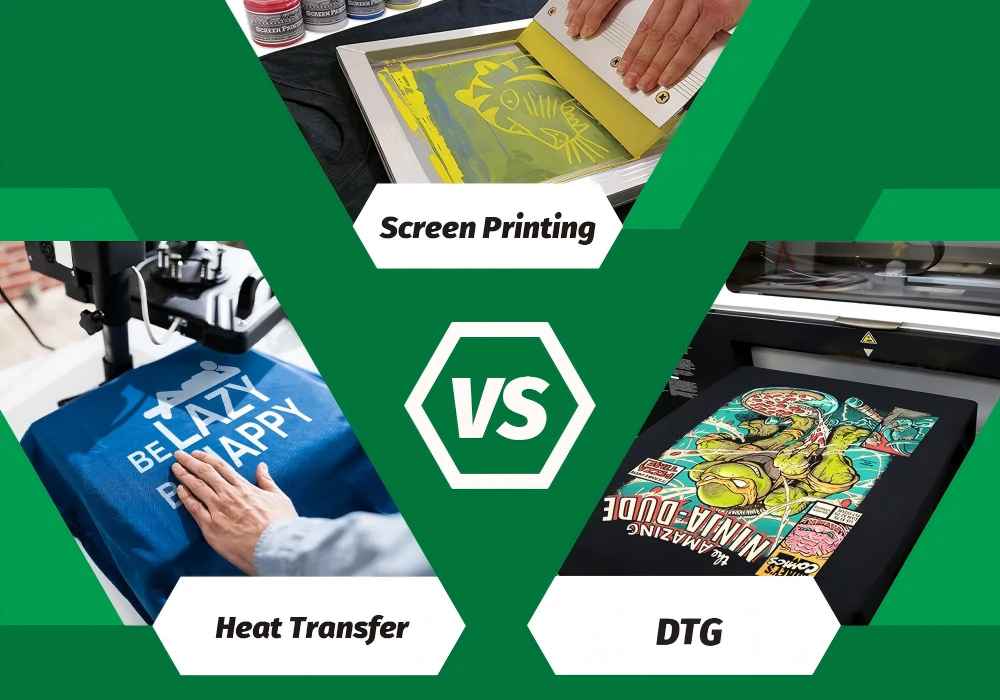Screen printing vs digital printing: Which technology is more suitable for your fashion brand?
Summary
In the fashion industry, printing technology directly affects the quality, Screen printing vs digital printing cost and market competitiveness of products. Screen printing and digital printing are the two most mainstream printing methods at present, each with its own advantages and applicable scenarios. This article will compare and analyze 10 key dimensions including production efficiency, cost, color performance, applicable fabrics, environmental protection, customization ability, durability, fineness, feasibility of small batch production and technical development trends to help you choose the printing method that best suits your brand needs.
1. Production efficiency comparison
Screen printing vs digital printing Argument: Screen printing is more efficient in large-scale production, while digital printing is more flexible in small-volume orders.
- Argument:
- Screen printing requires plate making, and can be printed at high speed after a single setting, suitable for orders of more than 100 pieces (500-1000 pieces per hour on average).
- Digital printing does not require plate making, and is directly printed from files, which is suitable for quick proofing or limited edition production of less than 50 pieces (about 50-200 pieces per hour).
2. Difference in cost structure
Screen printing vs digital printing Argument: Screen printing has a high initial cost but low unit cost, while digital printing has no setup fee but higher unit cost.
- Argument:
- Screen printing requires a screen production fee (about $20-$50 per color), but the unit cost can be as low as $0.50 in large quantities.
- Digital printing has no upfront costs, but the unit cost is about $3-$8, which is suitable for trial sales with low inventory risk.
3. Color expression
Argument: Screen printing has brighter colors, and digital printing can achieve more complex gradient effects.
- Argument:
- Screen printing uses high-concentration inks, which are especially suitable for Pantone spot colors and fluorescent colors.
- Digital printing simulates millions of colors through CMYK+white ink, which is suitable for photo-level printing or watercolor effects.
4. Applicable fabric range
Argument: Digital printing performs better on natural fibers (such as cotton and silk), while screen printing can cope with synthetic materials.
- Argument:
- Digital printing relies on ink absorption and has delicate color on pure cotton and silk, but polyester needs pretreatment.
- Screen printing can print on polyester, nylon and even plastic through ink adaptation.
5. Environmental assessment
Argument: Digital printing is more environmentally friendly, while screen printing needs to deal with chemical waste.
- Argument:
- Digital printing uses water-based ink, which is less polluting; solvent-based ink for screen printing needs professional recycling.
- Screen printing screen cleaning will produce wastewater, which must comply with environmental regulations.
6. Customization capability
Argument: Digital printing supports seamless personalization, while screen printing is suitable for fixed designs.
- Argument:
- Digital printing can have different patterns (such as names, numbers) for each piece, which is suitable for DTC brands.
- Screen printing has high redesign costs and is more suitable for bulk orders with unified designs.
7. Durability test
Argument: Screen printing is more wear-resistant, and digital printing requires post-color fixing.
- Argument:
- Screen printing ink has a thick layer and remains bright after 50 washes.
- Digital printing requires high-temperature curing or coating, otherwise it is easy to fade (especially dark fabrics).
8. Fineness and detail presentation
Argument: Digital printing is better at complex patterns (such as gradient colors, high-definition pictures).
- Argument:
- Digital printing resolution can reach 1440dpi, while screen printing is usually limited to 200-300dpi.
- Color registration errors in screen printing may cause edge misalignment.
9. Feasibility of small batch production
Argument: Digital printing is the first choice for fast fashion and trial sales, and screen printing requires a minimum order quantity.
- Argument:
- Digital printing has a minimum order of 1 piece, which is suitable for online celebrity co-branded products or seasonal designs.
- The MOQ of screen printing is usually 50-100 pieces, otherwise the cost is too high.
10. Technology development trend
Screen printing vs digital printing Argument: Digital printing is the mainstream in the future, but screen printing is irreplaceable in specific fields.
- Argument:
- The annual growth rate of digital printing technology is 12%, and it is breaking through the bottleneck of speed and cost (such as Kornit high-speed models).
- Screen printing still has an advantage in fields such as sportswear and promotional gifts that require special inks (such as foaming and luminous).
Summary: How to choose?
- Choose screen printing: large order volume, high color saturation, diverse fabrics, and controllable budget.
- Choose digital printing: small batches, complex designs, strong personalized needs, and high environmental protection requirements.
Final suggestion: Many brands adopt a hybrid model – digital printing for trial sales of popular products, and screen printing for mass production. Combine the two technologies to maximize benefits and creative freedom!

